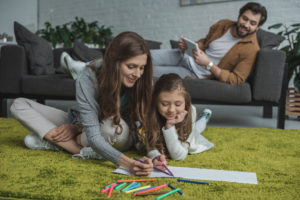Keeping It Simple

Throughout sessions with parents of children diagnosed with ADHD, one of the most common problems is motivating children to change certain behaviors. Behavior plans and charts have their place. They are very structured and useful. But when you take into consideration what can be practically implemented, it will make your job as a parent easier! Keeping it simple is key.
Extensive behavior charts and plans -- where parents are overwhelmed with behaviors to keep track of and are constantly having to place stickers, check marks, or smiley faces next to accomplished behaviors -- can be tedious and time-consuming. Even when they do work well in the home, what about in other environments? Often, these types of charts are not functional or usable when out in public, where inappropriate behaviors often occur.
So you, as parents, need solutions that can be implemented quickly, easily, and outside the home. And for this, keeping it simple is important! Following are 5 Manageable, Parent-Focused steps to re-direct public behavior.
- Focus on ONE behavior at a time. Often there are many behaviors that your child needs to improve upon. After all, they do have ADHD, so they will struggle with hyperactivity, impulsivity, focus/attention, frustration tolerance, and following multiple-step instructions, to name a few. Choose one behavior that is most important before you leave the house. For example, if your child really struggles with following directions the first time, decide to focus on ONLY that issue when you are out of the house for the next week or two (maybe more). (Note: once you begin to see some improvement, you can choose another behavior.)
- Create involvement and excitement by getting their “buy-in.” Children naturally love games. So, how do you turn behavior management into a game? Again, before you leave the house, explain the behavior that will be a focus. Decide together what points could be earned and/or involve them in the reward process. Your child's motivation to make change gets them interested and excited and takes the pressure off of you as a parent.
- Positive Reinforcement is key! We all enjoy someone pointing out the good things we are doing. It's even better when someone rewards us for it! Set up a plan that five points will earn an agreed-upon reward. To implement this on the fly, use your fingers as the points. Your child earns points when you “catch” them engaging in a desired behavior. Clearly explain what behavior will be a target and how many points they need to get the reward. For example, explain to your child that they will earn one point each time you catch them following directions the first time. When they earn five points, there will be a reward that you two agree upon. You might just be amazed at how much fun this is for you, too!
- The Reward. Okay, please don't break the bank on this! Rewards can be small and still have a major impact. BUT NOVELTY is key! Kids get bored easily, so changing up the reward, and reviewing with your child, is important to keep a plan fresh and the excitement rolling. The age of the child will guide you to what reward you pursue. For younger children 3-7 years old, some ideas include: giving small amounts of money, spending time with a parent, going to see a movie, playing a game, going to the Dollar Store, and picking out items to go into a treasure chest. For children ages 8-12 years old, try: to earn money towards a desired object, time playing with electronics, and engage in a desired activity with a friend or parent.
- The Reminder. We all need reminders, including your child! Reminders lead to success. I like to call this “predict and prompt.” Predict the situations in which your child may not remember to use the desired behavior and prompt them right before. This can be done like this: “Okay, Jimmy. Here is one of those times where if you follow the directions the first time, you can earn a point. Please go put your shoes on. Thanks!” You're more likely to see positive results with these reminders.
I hope this plan will help in keeping it SIMPLE enough for you to use on the go to make like easier for yourself! Give it a try, see what you think, and then let me know what works! So, now, what questions do you have?

